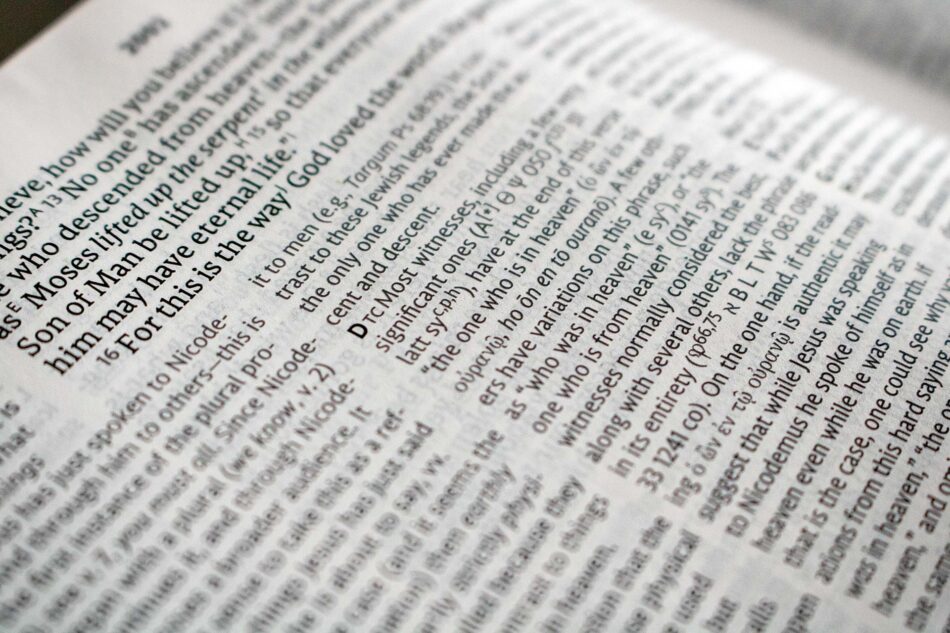The New English Translation’s unique approach to transparency and accountability helps you appreciate every English translation.
What sets one translation apart from another?
For many readers, the difference between translations depends on where they land on a spectrum between accuracy and readability. Some prefer a translation that closely follows the precise wording of the original languages. The more precisely word-for-word the translation is, the better, even if it’s harder to read. Others see the best translation as the one that can be most easily understood. The easier to read, the better, even if it doesn’t follow the original languages as closely as others.
The truth is all translations strive to balance both accuracy and readability. All aim to be both faithful to the original languages and clear for modern readers. Different translations might lean in one direction or the other, but they all share this same goal.
What if there were another way to set one translation apart from another? One that wasn’t focused on choosing between accuracy and readability? What if you were invited to look over a translator’s shoulder and see how they got from the biblical manuscripts to the English text you read? To not only see what they believe is the best way to interpret the text, but to know why they believe it, and what the other alternatives are.
That kind of transparency—that sort of accountability—is hard to imagine. But this is what the New English Translation (NET) offers to readers of all experience levels.
A new approach to transparency
Bible translation usually happens behind closed doors. Few outside the translation committee see the complex decisions that inform the words we read.
The NET’s translation committee took a different approach. Instead of doing their work in private, they made every working draft publicly available online and invited the world to take part in the vetting process. Bible scholars, ministers, and laypersons from around the world—the people who would be reading, studying, and teaching from the NET’s pages—logged millions of review sessions. They offered suggestions, raised concerns, and asked questions to aid the translators in their work.
But this approach did not stem from a desire to create a “translation by consensus.” Instead, it came from a desire for the global church to hold the translators accountable. The team filtered every piece of feedback through the very best insights from biblical linguistics, textual criticism, and an unwavering commitment to follow the text wherever it leads.
This uniquely transparent process resulted in not only a faithful and clear translation, but an accountable one, with the most extensive set of Bible translators’ notes ever created. More than 60,000 notes highlight every major translation decision, interpretive challenge, and textual variant. These extensive notes are delineated into three distinct types:
1. Translator’s notes
Translator notes explain the rationale for the translation and give alternative translations, interpretive options, and other technical information. These notes help readers understand the decisions made for the NET and enhance their appreciation of other translations.
2. Study notes
Study notes include on historical and cultural background, explaining obscure phrases or brief discussions of context. They also explore the theological points made by the biblical authors, cross references and references to Old Testament quotations or allusions in the New Testament. These notes serve to offer modern readers deeper insights into the text.
3. Text-critical notes
Text-critical notes highlight alternate (variant) readings found in the various groups of Hebrew and Greek biblical manuscripts.
The entire set of translators’ notes are available online at NetBible.org, online Bible study resources such as Bible Gateway, and in print in the NET Bible, Full Notes Edition.
Transparency for every reader and every translation
Teachers, scholars, and pastors will find these notes ideal for the kind of in-depth exploration of Scripture they are called to as they explore the richness of the biblical languages to communicate truth and encouragement. But the transparency these notes offer isn’t only for teachers. The NET’s transparency benefits every Bible reader.
The notes help readers discover richness of the biblical languages alongside the NET’s balanced and easy-to-understand English text. They encourage them to see how God’s Word speaks as powerfully today as when these words were first communicated to God’s people. And they help readers appreciate the NET, and every English translation.





